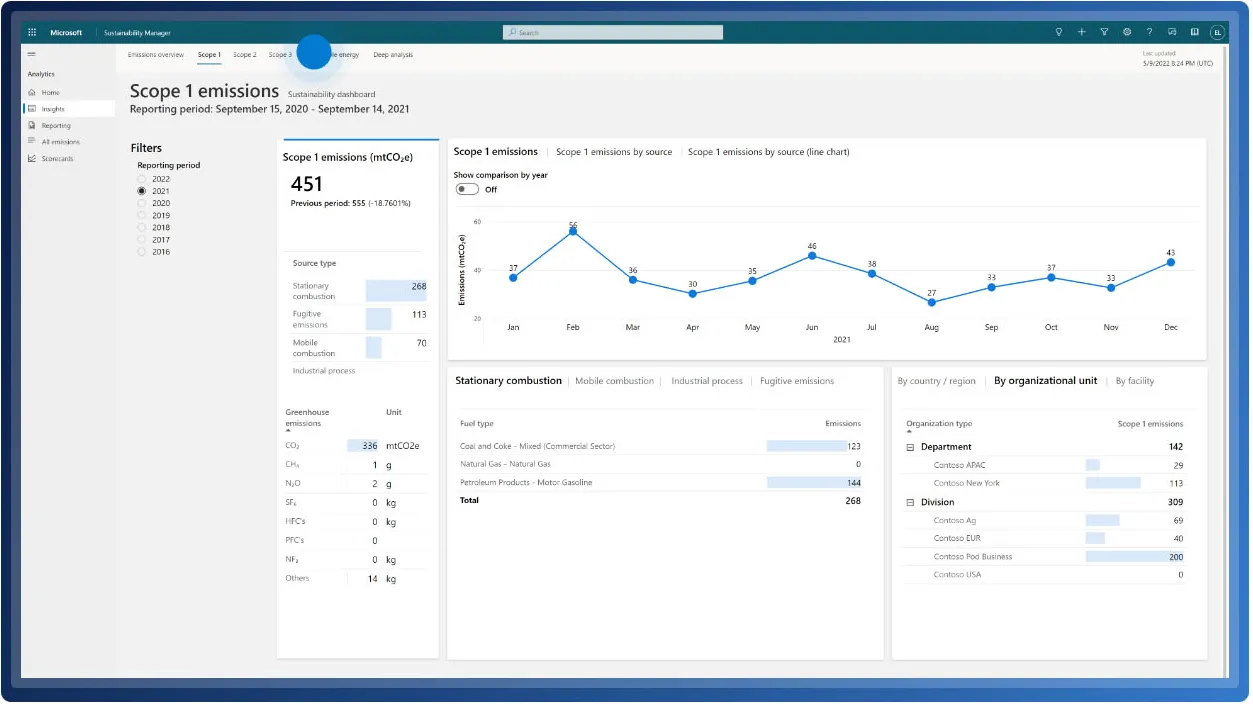
Can the Cloud Help Support Sustainability?
Cloud sustainability is becoming a priority for enterprises. Companies can reduce their carbon footprint by following some recommended best practices for cloud sustainability efforts.
Sustainability is a top corporate mission, driven by pressure from customers, investors and regulators. A recent study by Kyndryl and Microsoft found that 85% of organizations place a high strategic level of importance on achieving sustainability goals.1
Reducing CO2 emissions is a primary focus of sustainability. However, you may not realize that your carbon footprint is defined by more than emissions produced by your company’s vehicles, equipment and energy use. Emissions generated indirectly – up and down the value chain by your suppliers, partners and customers – are by far the largest part of a company’s carbon footprint.
That’s where cloud sustainability fits in. Nearly half of all workloads and data are now in the public cloud, according to the 2024 State of the Cloud
Report from Flexera2, and consequently, cloud sustainability is becoming a priority for enterprises.
Emissions generated indirectly – up and down the value chain by your suppliers, partners and customers – are by far the largest part of a company’s carbon footprint.
This blog is one of a two-part series exploring how data center colocation and cloud can provide sustainable alternatives to hosting services on premises. In this first blog, I look at cloud sustainability and recommend some best practices to guide your sustainability efforts in the cloud. In the second blog, I will delve into the ways colocation can deliver a sustainable data center option. Keep in mind, CoreSite provides both data center colocation and direct cloud connections to support your sustainability goals.
How Cloud Supports Sustainability
Before exploring ways to ensure cloud sustainability, it is important to acknowledge that simply moving to the cloud supports sustainability. Cloud providers have a lower carbon footprint and are more energy efficient, compared with an on-premises data center.
The hyperscalers show a strong commitment to sustainability by utilizing power efficiency, renewable energy sources, and energy-efficient cooling options. In addition, by enabling resource sharing across multiple enterprises and high server utilization, cloud providers are able to offer a more sustainable alternative to hosting services on-premises. Data center colocation provides a similar advantage, which will be discussed in the second blog in this series.
“Migrating applications to the cloud and shutting down data centers can significantly reduce IT carbon emissions because cloud service providers tend to run ultraefficient data centers on renewable energy,” global consulting firm McKinsey confirms.3
For example, 451 Research found that moving on-premises workloads to AWS cloud can lower carbon footprints by almost 80%, and this number goes up to 96% when AWS is powered by 100% renewable energy.4 Another report shows that Microsoft Cloud is 93% more energy efficient and up to 98% more carbon efficient than on-premises data centers.5
To ensure cloud sustainability, Google uses an AI‐powered recommendation system that improves energy efficiency – a new technology that can potentially deliver energy savings of around 30%.6
Best Practices for Cloud Sustainability
While cloud providers are making a significant impact, cloud customers also have a responsibility to maintain cloud sustainability. AWS explains, “When building cloud workloads, the practice of sustainability is understanding the impacts of the services used, quantifying impacts through the entire workload lifecycle, and applying design principles and best practices to reduce these impacts.”7
The following are recommendations to help achieve your cloud sustainability goals:
Use sustainability management tools: The hyperscalers offer AI-powered tools – such as Google’s Carbon Sense and Microsoft Sustainability Manager – to help track gross emissions, carbon footprint and waste reduction for customers’ cloud-based applications.
Optimize workloads: Managing your resource usage to optimize workloads in the cloud is an effective way to attain your cloud sustainability targets. Objectives include:
- Right-sizing workloads
- Eliminating idle resources
- Decommissioning unused assets
- Reducing the compute and storage resources required per transaction
- Aligning service-level agreements with sustainability goals
One of the greatest advantages of the cloud – dynamic scaling of resources – is ideal for sustainability. You can optimize your workloads by automatically adjusting your cloud-based resources based on demand. Leveraging cloud’s scalability will not only help your company be more sustainable but will also save on cloud costs.
Choose the right cloud provider: “While essentially all cloud providers have sustainability initiatives in place, their progress in meeting carbon reduction goals and strategies for achieving net zero carbon emissions varies wildly,” Ed Anderson, distinguished Research Vice President at Gartner warns.8
Many of the top cloud providers are committed to sustainability, but you need to find the right one. “Big cloud providers can be your best net zero friend. Make sure you understand where your cloud provider stands – they will become part of your Scope 3 carbon footprint,” Deloitte advises.9
Select the right region: “The choice of region for your workload significantly affects its KPIs, including performance, cost and carbon footprint,” AWS explains.6 For example, choosing a region with available renewable energy or low carbon intensity can reduce the carbon footprint of your cloud-based workload.
Foster a green culture: Even when you choose the right cloud provider, sustainability is still a shared responsibility, so your company must do its part as well. Cultivate a strong culture of sustainability throughout the organization so stakeholders view it as attainable – not just an aspiration – and understand how to make it happen. This requires embedding support for sustainability into decision-making processes.
To this end, Jeff Williams, CEO of JMJ, a culture transformation consulting firm, offers a few tips10:
- Make the business case for sustainability
- Conduct a sustainability culture assessment
- Communicate openly
- Address everyone’s concerns
- Recruit leaders from across the organization
- Set sustainability targets
Finding a Balance Between Cost and Sustainability
While cloud sustainability has become a corporate focus, cloud cost management is also a pressing priority, and companies must find a balance between these two essential self-imposed mandates.
“Although nearly half of all organizations have a defined sustainability initiative that includes carbon footprint tracking of cloud use, only 8% prioritize it in terms of cloud usage. On the other hand, 59% prioritize cost optimization,” according to the Flexera report.
Keep in mind, however, that cloud cost management and sustainability are not mutually exclusive – in fact, they can reinforce each other. Optimizing cloud workloads for sustainability can deliver a parallel economic advantage.
KNOW MORE
Contact us to find out how CoreSite supports sustainability and how you can reduce cloud costs even more with direct connectivity.
Click here to get started.
References
- From Vision to Impact: The Global Sustainability Barometer, Ecosystem, November 2023 (source)
- 2024 State of the Cloud Report, Flexera (source)
- Cloud-powered technologies for sustainability, McKinsey & Company, November 9, 2023 (source)
- The Carbon Reduction Opportunity of Moving to Amazon Web Services, 451 Research, October 2019 (source)
- The carbon benefits of cloud computing, Microsoft, 2020 (source)
- How Google is turning to AI to help address the climate crisis, GreenBiz, 2023 (source)
- Cloud sustainability, AWS (source)
- Gartner Predicts Hyperscalers’ Carbon Emissions Will Drive Cloud Purchase Decisions by 2025, Gartner, January 24, 2022 (source)
- Sustainable use of cloud computing, Deloitte (source)
- How To Create A Sustainability Culture, Jeff Williams, CEO of JMJ, Forbes, June 12, 2023 (source)









